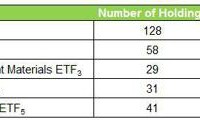Valuation Dashboard By Industries: Energy And Materials, October 2015
Summary 4 key fundamental factors are reported across industries in Energy and Basic Materials. They can be used to assess the valuation status of an industry relative to its historical average. They can also be used as a reference for picking quality stocks at a reasonable value. I started in September 2015 a monthly series of articles giving a valuation dashboard by sector of companies in the S&P 500 index (NYSEARCA: SPY ). The idea is to follow up a certain number of fundamental factors for every sector, to compare them to historical averages. This article is the first one of another series going down at industry level in the GICS classification. It covers Energy and Basic Materials. The choice of the fundamental ratios used in this study has been justified here and here . You can find in this article numbers that may be useful in a top-down approach. There is no due diligence, analysis, recommendations, or lists of individual stocks to consider. To make a complete picture by sticking a “bottom-up” under the “top-down”, you have to navigate in articles written by industry experts. Here is the link to articles tagged by sector. Methodology Four industry factors calculated by portfolio123 are extracted from the database: Price/Earnings “P/E”, Price to sales “P/S”, Price to free cash flow “P/FCF”, Return on Equity “ROE”. They are compared with their own historical averages “Avg”. The difference is measured in percentage and named with a prefix “D-” before the factor’s name (for example “D-P/E” for the price/earnings ratio). The methodology is quite different from the S&P 500 dashboard. In some industries, S&P 500 companies are very few, so mid- and small caps are included here. Also, the fundamental industry factors are not median values, but proprietary data by the platform. The calculation aims at eliminating extreme values and size biases, which is necessary when going out of a large cap universe. The drawback is that these factors are not representative of capital-weighted indices. They may be very useful as a reference values for picking stocks in an industry, but are less relevant for ETF investors. Industry valuation table on 10/26/2015 The next table reports the 4 industry factors. For each factor, the next “Avg” column gives its average between January 1999 and October 2015, taken as an arbitrary reference of fair valuation. The next “D-xxx” column is the difference between the historical average and the current value, in percentage. So there are 3 columns relative to P/E, and also 3 for each ratio. P/E Avg D- P/E P/S Avg D- P/S P/FCF Avg D- P/FCF ROE Avg D-ROE Energy Equip. & Services 17.2 24.2 28.93% 0.81 1.73 53.18% 10.58 35.34 70.06% -6.2 7.34 -184.47% Oil/Gas/Fuel 19.65 18.53 -6.04% 2.06 3.35 38.51% 20.11 29.03 30.73% -6.59 4.47 -247.43% Chemicals 19.61 18.48 -6.11% 1.46 1.21 -20.66% 34.93 25.37 -37.68% 8.68 6.74 28.78% Constr. Materials 34.81 21.44 -62.36% 1.33 1.16 -14.66% 65.74 40.5 -62.32% 12.38 5.77 114.56% Packaging 20.11 17.96 -11.97% 0.91 0.61 -49.18% 21.67 20.09 -7.86% 18.77 8.34 125.06% Metals&Mining 21.49 19.83 -8.37% 1.55 2.65 41.51% 16.77 25.53 34.31% -19.32 -8.6 -124.65% Paper&Wood 26.08 21.27 -22.61% 0.75 0.72 -4.17% 20.16 22.81 11.62% 9.09 4.99 82.16% Valuation The following charts give an idea of the current status of Energy and Materials industries relative to their historical average. In all cases, the higher the better. Price/Earnings: Price/Sales: Price/Free Cash Flow: Quality Relative Momentum The next chart compares the price action of the SPDR Select Sector ETF in Materials (NYSEARCA: XLB ) and Energy (NYSEARCA: XLE ) with SPY. (click to enlarge) Conclusion Both sectors are in a downtrend, in absolute and relative to the broad market. At the industry level, Energy Equipment & Services, Oil/Fuel/Gas and Metals/Mining look undervalued relative to their own historical averages for several factors, but they are in negative territory for quality. At the opposite, Chemicals, Construction Materials and Packaging are above their historical average in quality, but overpriced for the 3 valuation factors. No industry in these two sectors looks very attractive. However, comparing individual fundamental factors to the industry factors provided in the table may help find quality stocks at a reasonable price. A list of stocks in energy and basic materials beating their industry factors is provided on this page . If you want to stay informed of my updates on this topic and other articles, click the “Follow” tab at the top of this article. You can choose the “real-time” option if you want to be instantly notified.
